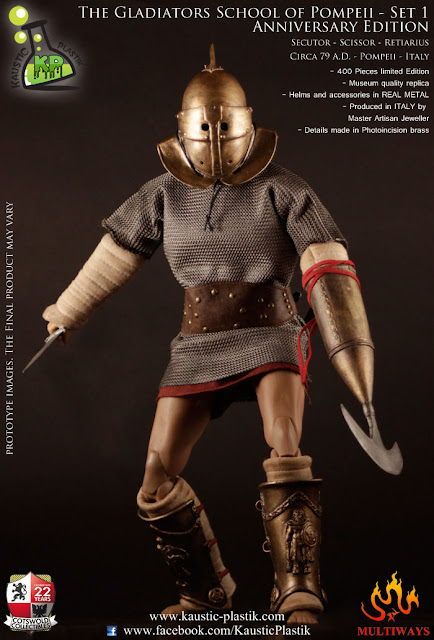Kaustic Plastik are proud to announce The Kaustic Plastik FIRST ANNIVERSARY Edition box! Only 400 pieces LIMITED EDITION! This set will be a triple pack set. Inside you will find all the accessories to build 3 different Gladiators: Secutor - Scissor - Retiarius. Museum quality replica, helms and accessories in real metal die-cast and produced in Italy by master artisan jeweller. This release will feature the "Archaeology corner" by Dott. Luca Nejrotti.
A Secutor (pl. Secutores) was a class of gladiator in ancient Rome. Thought to have originated around 50 AD, the Secutor ("Follower", from sequor "I follow, come or go after") was armed similarly to the Murmillo gladiator, and like the Murmillo, was protected by heavy armour. A Secutor usually carried a short sword, a gladius, or a dagger. The Secutor was specially trained to fight a Retiarius, a type of lightly armoured gladiator armed with a trident and net.
The very distinctive helmet of the Secutor had only two small eye-holes, in order to prevent a Retiarius's trident from being thrust through the face, as well as a rounded top, so as not to get caught in a net. The flanges protecting his neck were smooth and shaped like fish fins for this purpose. Because of the weight and lack of space in the helmet, the secutor had to win quickly, lest he fall to exhaustion or faint due to breath constrictions.
The secutor wore a loincloth, and a wide belt (much like that of the retiarius). On his right arm, he wore a manica (a heavy linen or metal wrapping tied with leather thongs), and on his left leg, he wore an ocrea (a greave made of boiled leather or metal). He also carried a scutum (a curved rectangular shield) to protect himself.
The Scissor (pl. scissoris) was a type of Roman gladiator about which almost nothing beyond the name, meaning "cutter, cleaver, render" (from scindo, cf. "schism") is known.
German historian and experimental archeologist Marcus Junkelmann has propagated an idea, based on an unlabeled, unclear image that he decided might be a scissor, that this type of gladiator fought using a weapon consisting of a hardened steel tube that encased the gladiator's entire forearm, with the hand end capped off and a semicircular blade attached to it. A handle inside the tube might have allowed the gladiator to maintain control in the heat of battle. This weapon might have been both deadly and versatile; the gladiator could use his protected arm to block his opponent's blows and quickly counterattack, the shape of the blade being such that even the slightest touch could cause a serious wound.
A retiarius (plural retiarii; literally, "net-man" or "net-fighter" in Latin) was a Roman gladiator who fought with equipment styled on that of a fisherman: a weighted net (rete, hence the name), a three-pointed trident (fuscina or tridens), and a dagger (pugio). The retiarius was lightly armoured, wearing an arm guard (manica) and a shoulder guard (galerus). Typically, his clothing consisted only of a loincloth (subligaculum) held in place by a wide belt, or of a short tunic with light padding. He wore no head protection or footwear.
The retiarius was routinely pitted against a heavily armed secutor. The net-fighter made up for his lack of protective gear by using his speed and agility to avoid his opponent's attacks and waiting for the opportunity to strike. He first tried to throw his net over his rival. If this succeeded, he attacked with his trident while his adversary was entangled. Another tactic was to ensnare his enemy's weapon in the net and pull it out of his grasp, leaving the opponent defenseless. Should the net miss or the secutor grab hold of it, the retiarius likely discarded the weapon, although he might try to collect it back for a second cast. Usually, the retiarius had to rely on his trident and dagger to finish the fight. The trident, as tall as a human being, permitted the gladiator to jab quickly and keep his distance.
The retiarius is very similar to the one Kaustic Plastik first released in 2011. I did a two-part review of the Kaustic Plastik 1/6 Retiarius "Astacius" 12-inch roman gladiator figure HERE and HERE. You can see more close-up pictures of the amazing detailing in my earlier posts :)









No comments:
Post a Comment